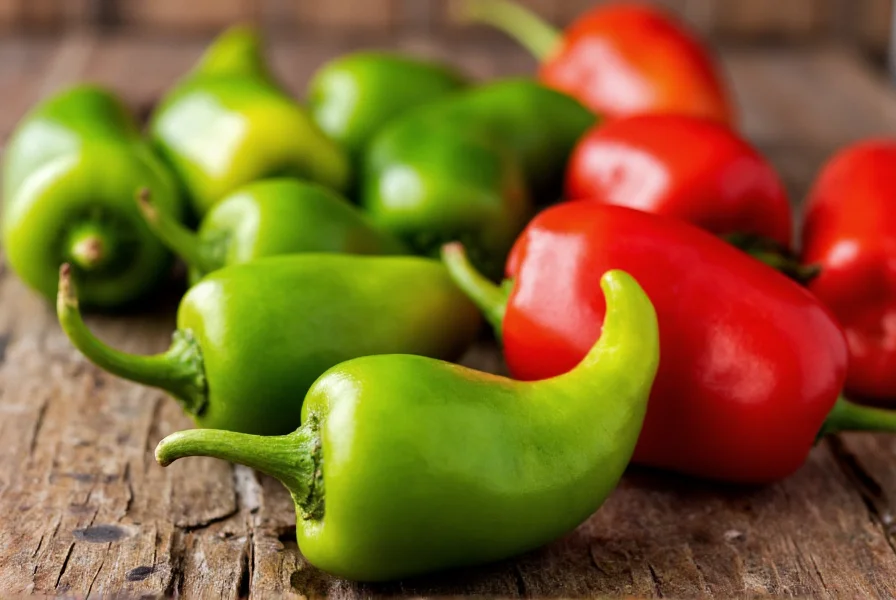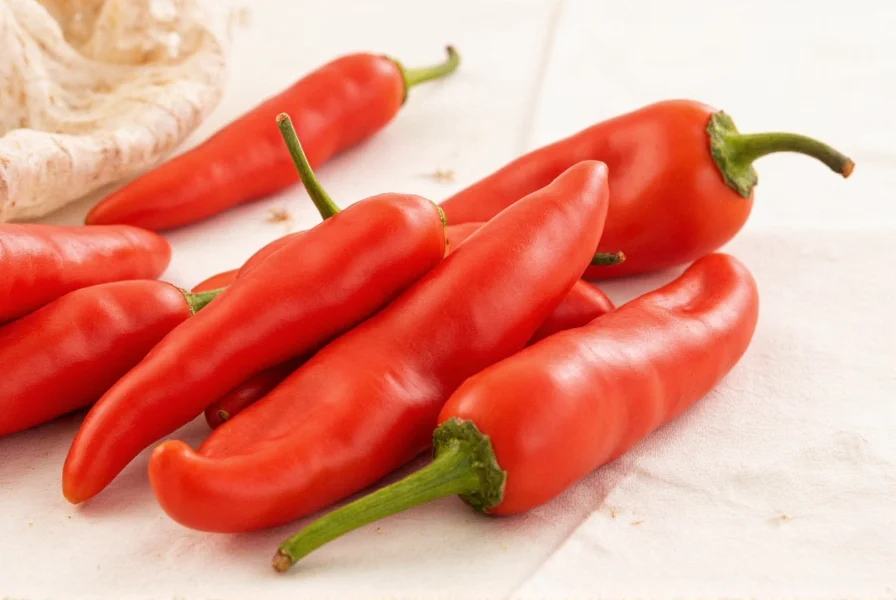Corno di toro peppers are sweet Italian frying peppers known for their distinctive curved horn shape, vibrant color progression from green to deep red, and mild heat level (0-5,000 Scoville units). These versatile peppers excel in roasting, grilling, and stuffing applications due to their thick walls and sweet flavor profile.
The corno di toro pepper, whose name literally translates to “bull's horn” in Italian, represents one of the most versatile sweet pepper varieties in Mediterranean cuisine. This elongated, curved pepper typically measures 6-8 inches in length with a distinctive tapered shape that widens toward the base. Understanding its unique characteristics helps home cooks and professional chefs maximize its culinary potential.
Physical Characteristics and Growth Patterns
Corno di toro peppers begin their life cycle as vibrant green specimens before gradually transitioning through yellow and orange stages to reach a deep, rich red when fully mature. The thick walls—approximately 1/4 inch thick—contribute to their excellent roasting properties and make them ideal for stuffing applications. Unlike many sweet peppers, corno di toro maintains structural integrity during cooking, preventing the sogginess that often plagues thinner-walled varieties.

Flavor Profile and Heat Level Analysis
Despite their imposing size and dramatic appearance, corno di toro peppers register minimal heat on the Scoville scale, typically measuring between 0-5,000 units. For context, this places them in the same heat category as standard bell peppers (0 units) and significantly milder than jalapeños (2,500-8,000 units). The flavor profile reveals complex sweetness with subtle grassy notes when harvested green, developing richer, fruitier characteristics as they mature to red.
| Pepper Variety | Scoville Heat Units | Flavor Characteristics | Best Culinary Uses |
|---|---|---|---|
| Corno di toro (green) | 0-1,000 | Grassy, slightly bitter | Grilling, stir-fries |
| Corno di toro (red) | 1,000-5,000 | Sweet, fruity, complex | Roasting, sauces, stuffing |
| Bell pepper | 0 | Mild, vegetal | Raw applications, salads |
| Cubanelle | 0-1,000 | Sweet, delicate | Frying, sandwiches |
Culinary Applications and Cooking Techniques
Chefs specializing in Italian cuisine prize corno di toro peppers for their exceptional performance in traditional preparations. When roasting corno di toro peppers, the thick walls blister beautifully while retaining structural integrity—a quality that makes them superior to thinner varieties for dishes like peperonata, the classic Italian sweet and sour pepper stew. The peppers' natural curvature creates perfect pockets for stuffing with rice, breadcrumbs, or cheese mixtures.
For optimal flavor development, many professional kitchens employ a two-stage cooking process: first charring the exterior over open flame to develop smoky complexity, then slow-roasting to tenderize the thick walls. This technique maximizes the natural sugars while preserving the pepper's distinctive shape. When preparing corno di toro peppers for salads or antipasti, allow them to cool completely in a covered container—this traps steam and facilitates easy skin removal while concentrating flavors.
Substitution Options for Corno di Toro Peppers
When authentic corno di toro peppers prove difficult to source, several suitable alternatives exist depending on your culinary application. For roasting and stuffing applications, cubanelle peppers offer the closest match in terms of wall thickness and mild heat profile. Hungarian wax peppers provide a similar shape but with slightly more heat (5,000-15,000 Scoville units), making them better suited for dishes requiring subtle warmth.
For traditional Italian preparations like peperonata, consider combining bell peppers and pimientos to approximate the flavor progression of maturing corno di toro. The bell peppers provide structural integrity while pimientos contribute the characteristic sweetness of fully ripened corno di toro. This combination works particularly well for peperoncini ripieni (stuffed peppers) when authentic corno di toro aren't available.
Growing Corno di Toro Peppers Successfully
Gardeners seeking to cultivate corno di toro peppers should note their extended growing season requirements—approximately 75-85 days from transplant to first harvest. These plants thrive in warm conditions with consistent moisture and well-draining soil. Unlike many sweet pepper varieties, corno di toro demonstrates remarkable resistance to blossom end rot when provided with consistent calcium supplementation.
For optimal fruit development, pinch off the initial flowers during the first flowering cycle. This practice redirects the plant's energy toward root and branch development, resulting in significantly higher yields during subsequent flowering periods. Harvesting corno di toro peppers at the green stage provides more vegetal flavor, while allowing them to fully ripen to red develops their characteristic sweetness but requires additional garden time.
Storage and Preservation Methods
Proper storage extends the usability of corno di toro peppers significantly. Keep unwashed peppers in the crisper drawer of your refrigerator for up to three weeks. For longer preservation, roast and peel the peppers before packing them in olive oil—this traditional Italian preservation method maintains flavor and texture for up to six months when properly sealed.
Freezing represents another excellent option for preserving peak-season corno di toro. After roasting and peeling, portion the peppers into recipe-sized amounts before freezing. This approach preserves both flavor and texture better than freezing raw peppers, which often develop undesirable sogginess upon thawing. Many Italian home cooks prepare large batches during harvest season specifically for freezing, ensuring year-round access to this culinary staple.
Nutritional Benefits of Corno di Toro Peppers
Beyond their culinary versatility, corno di toro peppers deliver impressive nutritional benefits. A single medium pepper provides more than 100% of the recommended daily intake of vitamin C, along with significant amounts of vitamins A, B6, and K. The vibrant red varieties contain higher concentrations of carotenoids, including beta-carotene and lycopene, which function as powerful antioxidants.
Unlike many vegetables that lose nutritional value during cooking, corno di toro peppers actually increase their antioxidant availability through roasting. The application of heat breaks down cell walls, making these beneficial compounds more accessible to the body. This characteristic makes roasted corno di toro peppers particularly valuable in health-conscious cooking without compromising traditional flavor profiles.
Traditional Italian Recipes Featuring Corno di Toro
Corno di toro peppers feature prominently in several regional Italian specialties. In Calabria, they appear in 'Nduja-enhanced preparations where their sweetness balances the spicy spreadable salami. Northern Italian kitchens incorporate them into peperoni in agrodolce, a sweet and sour preparation featuring vinegar, sugar, and aromatic herbs.
One particularly noteworthy application involves peperoni alla pizzaiola—peppers prepared with the classic pizza seasoning of oregano, garlic, and tomatoes. The thick walls of corno di toro hold up beautifully to the acidic tomato sauce, maintaining texture while absorbing flavors. For authentic preparation, use extra virgin olive oil from the same region as your peppers to create a harmonious flavor profile that showcases the corno di toro's natural qualities.
What's the difference between corno di toro and cubanelle peppers?
Corno di toro peppers are longer (6-8 inches) with thicker walls compared to cubanelles (4-6 inches). Corno di toro has a more pronounced curve resembling a bull's horn, while cubanelles are straighter. Both are sweet peppers, but corno di toro develops more complex sweetness when fully ripened to red, whereas cubanelles maintain consistent mild flavor throughout ripening.
Can I use corno di toro peppers raw in salads?
Yes, but green corno di toro peppers have a slightly bitter, grassy flavor when raw that some find overpowering. For salads, use fully ripened red corno di toro which offers sweeter, more complex flavor. Thinly slice and marinate in olive oil and vinegar for at least 30 minutes to soften the texture and enhance sweetness before adding to salads.
How do I properly roast corno di toro peppers?
Place whole peppers directly over gas flame or under broiler, turning frequently until completely blackened. Transfer to sealed container for 10-15 minutes to steam, then peel skin starting from stem end. The thick walls of corno di toro require this steaming step for proper skin removal. Slice lengthwise to remove seeds while maintaining structural integrity for stuffing applications.
Are corno di toro peppers suitable for canning?
Yes, corno di toro peppers are excellent for canning due to their thick walls which maintain texture better than thinner varieties. For best results, roast and peel before packing in olive oil with garlic and herbs. Their natural sweetness balances the acidity required for safe canning, creating a product that closely resembles traditional Italian preserved peppers.
What's the best way to grow corno di toro peppers in containers?
Use containers at least 18 inches in diameter with excellent drainage. Start seeds indoors 8-10 weeks before last frost. When transplanting, bury stem up to first set of leaves to encourage stronger root growth. Container-grown corno di toro requires consistent moisture—allowing soil to dry between waterings causes blossom drop. Feed with balanced organic fertilizer every 3 weeks, and provide at least 6 hours of direct sunlight daily for optimal fruit production.











 浙公网安备
33010002000092号
浙公网安备
33010002000092号 浙B2-20120091-4
浙B2-20120091-4